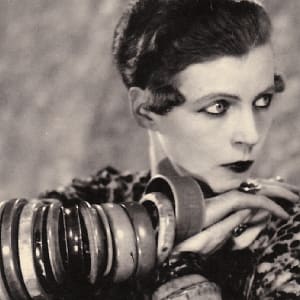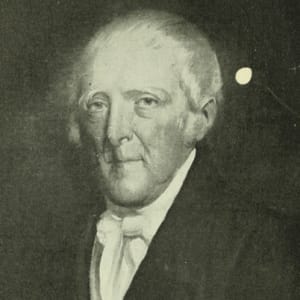
Nancy Cunard
Nancy Cunard was a 20th century poet, publisher and activist who rejected a life of privilege to crusade for racial equality and Spanish Civil War victims.
Synopsis
Born in London in 1896, shipping heiress Nancy Cunard shunned her privileged upbringing to pursue artistic fulfillment and social justice. An icon of the Parisian intellectual community, she published multiple volumes of poetry, founded the Hours Press in the 1920s, and later chronicled the Spanish Civil War. Suffering from alcoholism and destitute in her later years, Cunard died in Paris in 1965.
Early Years
Nancy Clara Cunard was born on March 10, 1896, in Leicestershire, England to Sir Bache Edward Cunard and Lady Maude Alice (Burke) Cunard. The great-granddaughter of Samuel Cunard, founder of a successful transatlantic shipping line, she grew up in a 700-year-old castle on an immense estate.
Cunard realized at an early age that her parents lived separate lives. Sir Bache Cunard enjoyed outdoor sports and otherwise sequestered himself in a tower for his metalwork. Maud Burke "Lady" Cunard, on the other hand, had a thirst for social interaction and threw parties to mingle with the leading artists, writers and politicians of the day. It was through this activity that young Nancy met Irish writer George Moore, who helped spark her interest in the arts.
Despite receiving the opportunity to travel with her parents, Cunard mainly interacted with her governesses and servants, and, as such, had a lonely childhood. However, her life changed dramatically at age 14, when her parents split and she moved to London with her mother.
Poet, Muse and Publisher
Cunard attended private schools in London, Germany and Paris, where she was electrified by her exposure to other young intellectuals. She fell in with a bohemian group that included poet Ezra Pound, writer Iris Tree and painter Augustus John. As part of the "Corrupt Coterie," they shunned conventional activities to discuss art and politics at Parisian cafes.
Cunard began pursuing her own artistic interests, and had several poems published by 1916. That year, she also married a wounded World War I veteran and former cricket player named Sydney Fairbairn, but they separated less than two years later.
After moving to Paris in 1920, Cunard emerged at the forefront of a social circle of artists and Communist Party supporters. A striking beauty with large eyes, she was romantically involved with such intellectual heavyweights as Pound, T.S. Eliot and Pablo Neruda. Her style and force of personality earned homage from writers Ernest Hemingway and Aldous Huxley, and she was profiled by famed photographers Man Ray and Cecil Beaton.
Cunard also continued writing poetry and published three volumes: Outlaws (1921), Sublunary (1923) and Parallax (1925). She later moved to a farmhouse in Réanville, and in 1928 she founded the Hours Press to provide an outlet for young writers, including playwright Samuel Beckett.
Publisher and Social Crusader
During this time, Cunard struck up a life-changing relationship with African-American jazz pianist Henry Crowder. Stunned by Crowder's descriptions of racial injustice, she felt the sting of prejudice first-hand with the unsavory British tabloid coverage of their meetings, as well as her mother's attempts to torpedo their relationship.
Cunard responded by attacking her mother's privileged values in her 1931 pamphlet Black Man and White Ladyship. She also successfully sued the British press for libel, and used the proceeds to publish Negro: An Anthology (1934). Totaling nearly 900 pages, Negro featured essays, fiction and poetry dedicated to black history and culture, and counted W.E.B. Du Bois, Zora Neale Hurston and Langston Hughes among its 150 contributors. Despite the epic scope of the project, it was derided by the press and largely ignored by the public.
Cunard next found inspiration with the onset of the Spanish Civil War. She moved to Spain in 1936, and often put herself in harm's way to deliver battlefield coverage for such publications as The Manchester Guardian, The Associated Negro Press and Crisis. She exposed the squalid conditions of the holding camps along the Spain-France border, and even took to the streets to beg for Spanish refugees.
Cunard also visited South America, the Caribbean and Africa around this time to report on the effects of colonialism. She resumed her fight against fascism as a member of the Free French, and she later assisted the Supreme Headquarters, Allied Expeditionary Force during World War II by broadcasting coded material.
Later Years and Death
Her Réanville home was destroyed during the war, Cunard traveled extensively in its aftermath. She continued her efforts to find homes for Spanish refugees, and produced memoirs of Norman Douglas and George Moore.
Cunard drank heavily in her later years, her mental and physical health deteriorating as the remains of her money vanished. Shortly after her 69th birthday, she was found unconscious on a Paris street. She was revived at the Hôpital Cochin, but soon lapsed into a coma, and died on March 17, 1965.
Although not as well known as the famed writers and artists she once rubbed elbows with, Cunard is remembered with an inventory of letters, poems and scrapbooks at the Harry Ransom Center of the University of Texas at Austin. Lois Gordon chronicled her life and impact as a cultural trailblazer in the 2007 biography, Nancy Cunard: Heiress, Muse, Political Activist.




